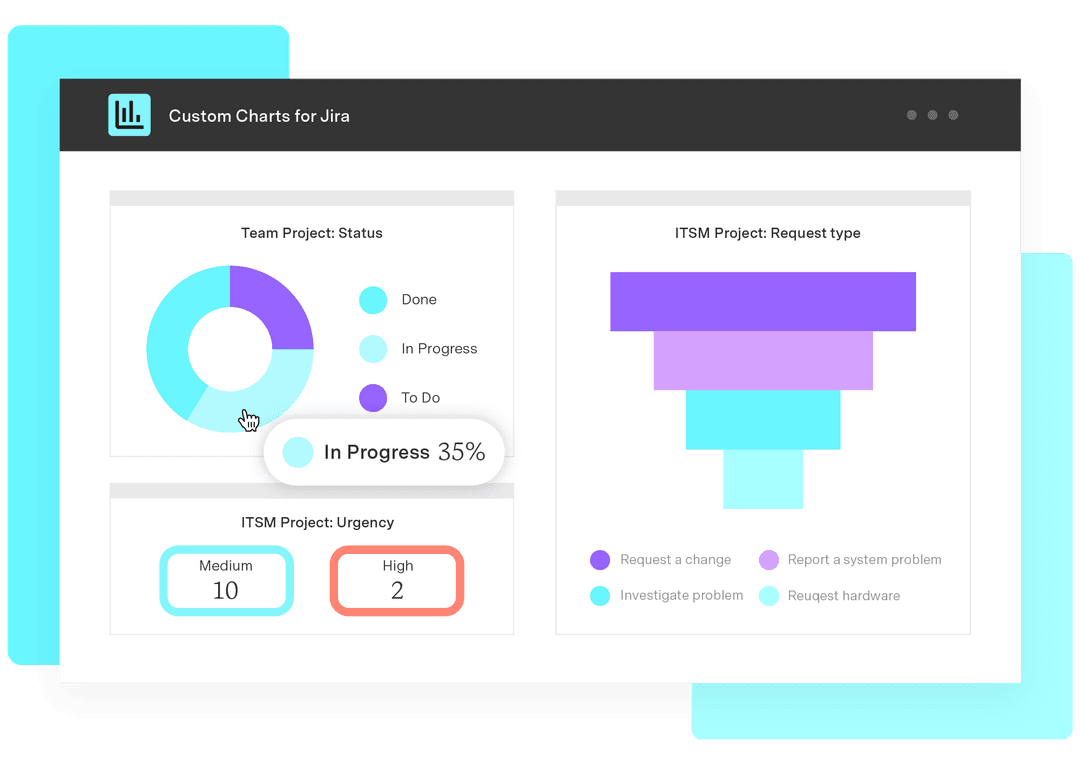5 ITSM use cases for Custom Charts for Jira
Tempo Team
Recently we took a closer look at how Jira Service Management facilitates better service delivery in IT service management (ITSM). We looked in particular at JSM’s reporting capabilities for ITSM use cases and how much more powerful they are than many traditional IT helpdesks.
The thing is, although JSM’s native reports are powerful, they’re not very customizable, especially when it comes down to reporting on dashboards. There are great reporting gadgets on the Atlassian Marketplace that offer the necessary visualization options that allow teams to really home in on what they need to do to continuously improve, like Custom Charts for Jira.
Let’s take a look at some reporting options in Custom Charts that support a number of ITSM use cases.
Reviewing issues submitted by each customer organization
Using Jira Service Management (JSM), users can group service desk customers into individual Organizations. The Organizations field can be used in the Custom Charts Chart By and Group By settings, and in any Jira Query Language (JQL) that you use in your charts. It can be extremely helpful for agents to understand details around the tickets submitted by each customer.
Priority of issues submitted by each organization
To create the 2D Stacked Bar Chart below, we’re pulling in issues from our Support project and have the Chart By set to Priority, and the Group By set to Organizations.
We can see below that out of the 10 high priority issues, the Bluth Company has submitted 90% of those issues (9 out of 10).

Knowing this statistic can help gain a better understanding of the customer, and encourage some important dialogue about why their issues are of such high priority.
Status of issues submitted by each organization
To create the 2D Stacked Bar Chart below, we’re pulling in issues from our Support project and this time we have the Chart By set to Status, and the Group By set to Organizations.
We can see that Rose Apothecary submitted 12 requests to the support portal, but none of them have been resolved. They also have a few requests that have been escalated. Most of the requests from the Bluth Corporation have been escalated and very few have been resolved. And meanwhile the team has resolved most of Wayne Enterprise’s requests.

Having insight into this information can help us understand which customers may be at risk. If Rose Apothecary and the Bluth Corporation have barely any issues resolved, and a fair amount of escalations, there’s a chance they may not be satisfied with our customer service. The team can dig further into the status of these requests to determine what’s preventing the team from completing them.
Issues submitted by each organization each month
To create the 2D Stacked Bar Chart below, we’re pulling in issues from our Support project and have the Chart By set to Organizations, and the Group By set to Created. In screenshot 1, we can see that the customers at Los Pollos Hermanos only submitted 3 requests the week of July 4th, but quadrupled that the following week (12 submissions). In screenshot 2, we can see that Wayne Enterprises falls on the opposite end of the spectrum – they cut their submissions almost in half between the 2 weeks.
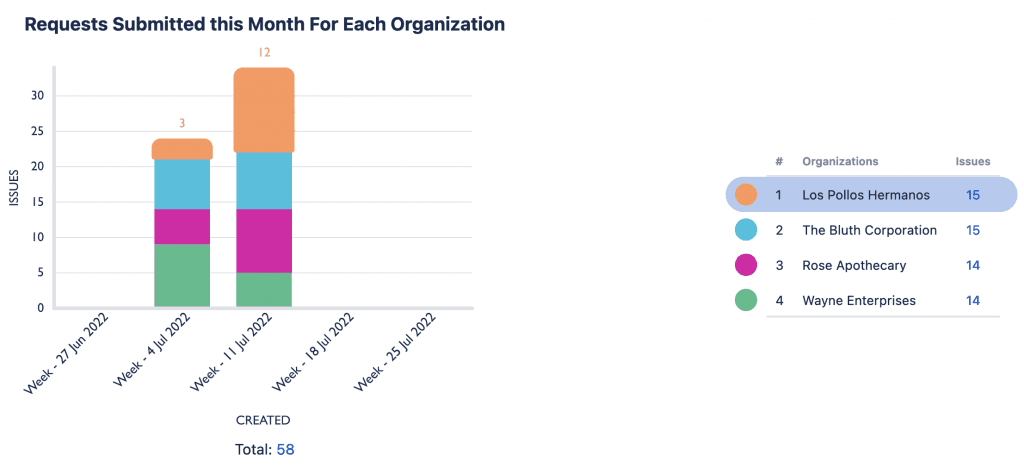

Visualizing this data enables the team to dig into the reasoning behind the inconsistent submissions. Do the customers at Wayne Enterprises not trust us to efficiently resolve their requests, so they’ve stopped contacting us for help? Or is our product working well enough for them that their needs are being met? And is our product not working well enough for Los Pollos Hermanos, which is why there’s been a major requests influx?
SLA breached vs not breached per project
A huge part of running a successful business is building a healthy customer base. Establishing trust with customers is crucial to this. In IT Service Management, Service-Level Agreements (SLAs) are used to create that trust. They essentially serve as a contract between customers and the service provider regarding time-frames for work completion and services. Setting clear expectations with customers and meeting or exceeding those expectations offers an instant and tangible way for a team to see how well they’re performing.
All Jira Service Management projects ship with SLAs that project admins can customize. Project admins can even add additional SLAs to meet the needs of the business. The main customization settings for SLAs include:
SLA time goals, e.g. the “Time to First Response” SLA is considered breached if an agent does not respond to a ticket within 24 hours
SLA conditions for when the SLA countdown starts, stops, and pauses toward the time goal, e.g. when an issue is created, have the SLA counter start, and when the support team is waiting for a response from the customer, have the SLA counter pause.
Using Custom Charts for Jira, ITSM teams can build simple but powerful reports utilizing this information. In the example below, we are analyzing all JSM projects in a Jira instance. Our service teams are aligned on SLAs, in that they all use the same set of standard SLAs (Time to First Response, Time to Resolution, etc.). When configuring Custom Charts, the Source of the chart is set to be All Issues (a saved filter we’ve created); the Chart Type is a 2D Stacked Bar Chart; the Chart By is set to Project; and the Group By is set to Time to First Response SLA.
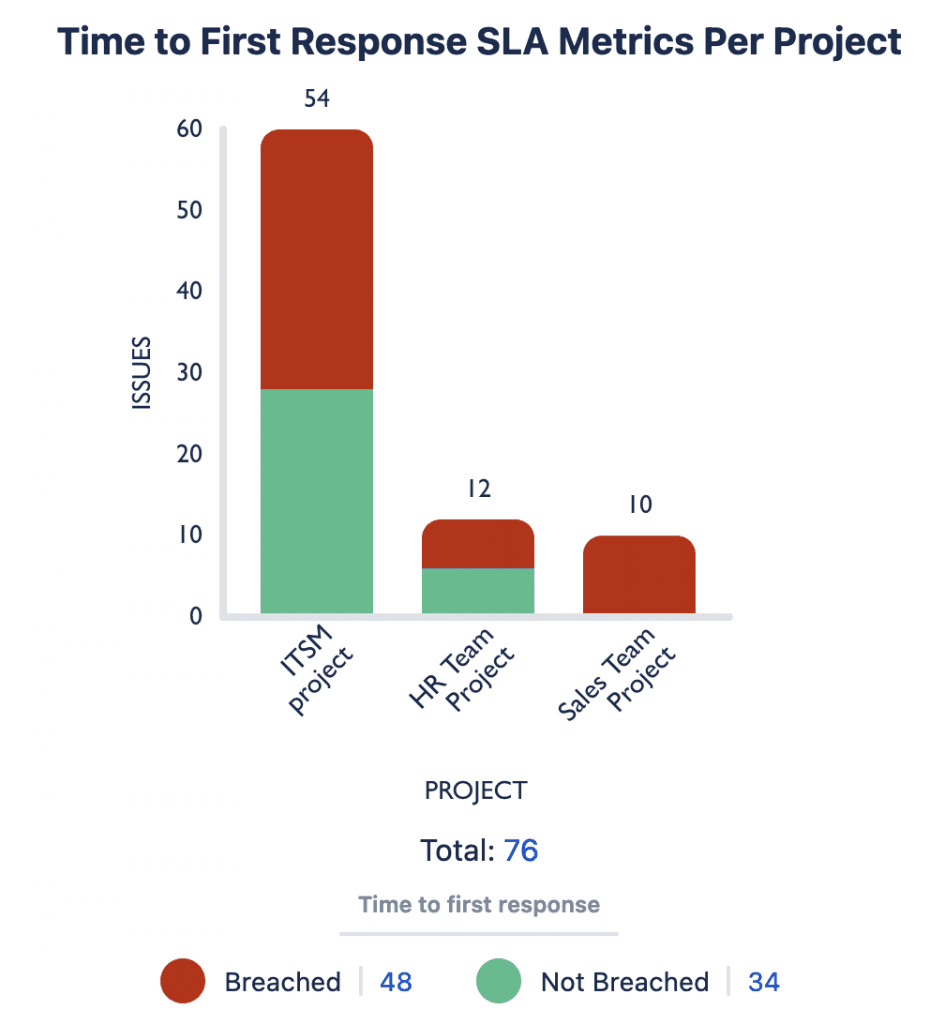
Using this chart, we have direct insight into whether our various teams are meeting their SLA goals. We can see that in the ITSM Project, 32 out of 54 issues have breached the goal for the Time to First Response SLA. The team can then come together to have a conversation around either resetting the SLA goal or figuring out how they can work more efficiently toward meeting it. (Remember, since SLAs serve as a contract between the customer and the team, it’s important to keep customers in the loop on SLA goals.)
Requests per assignee
According to a recent burnout survey by Deloitte, nearly 70% of professionals feel their employers are not doing enough to prevent or alleviate burnout within their organization. Burnout not only affects an employee’s work life but also their personal life. 83% of the survey respondents reported that burnout negatively impacted their relationships outside of the office.
An important way to prevent burnout is to ensure your team members feel supported, and that they are not overworked. Using Custom Charts for Jira, supervisors can build reports to visually represent the workload of each team member. That way, if there seems to be a trend around a specific user taking on most of the JSM requests, the problem can be caught early on and the workload can be better distributed.

In the example above, we are using a 1D Bar Chart in Custom Charts to visualize Requests per Assignee in our ITSM project. We can see that George Michael is the assignee for 11 requests out of 18. That means he is responsible for over half of all requests from customers. Compared to the other team members, George Michael is taking on a lot more work. If that trend continues, George Michael will probably experience burnout and might even leave the business for another opportunity where he feels more supported.
Knowing this upfront, the team can discuss why George Michael owns the majority of requests, then figure out a way to prevent this from happening in the future. After all, teams are called “teams” for a reason. Most likely, Maebe, Lucille, or Tobias will be more than willing to help make George Michael’s day-to-day a bit easier by taking some requests off his plate.
A huge part of ITSM is ensuring the team is delivering a quality service to the customer, so it’s important we keep our team members happy so they can do and feel their best.
Requests broken down by component
When it comes to ITSM, the umbrella covers a wide span of topics; not only are teams working on IT issues and troubleshooting, but also requests and support for new hardware, software, and applications. All Jira projects come with Components, which are subsections of a project that allow teams to better organize requests from customers. For example, a Hardware component can be created in a JSM project that can then be automatically assigned to all laptop-related requests.
By building a Custom Charts Pie Chart that displays our support requests by Component, the team can get a good understanding of the nature of requests that are coming into the portal. As we can see below, most customers are submitting requests around Hardware (59%). Knowing this, the team can delve further into these requests and have some discussions.
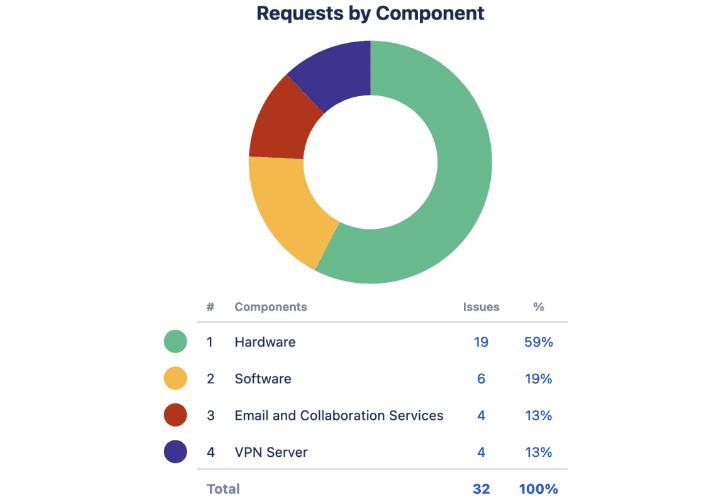
Would it be beneficial to train the team further on hardware troubleshooting? Do we need to hire new team members that have experience assisting with hardware-related requests? By having appropriate data on our requests and asking these questions, we can build a more functional team and better assist our customers.
Customer satisfaction (CSAT) ratings by assignee
The team is the heart of your ITSM, but customers are the blood that pumps through it. Customers should feel valued, respected, and listened to.
In Jira Service Management projects, project admins can enable customer satisfaction (CSAT) surveys that are sent to customers at the end of each support interaction, i.e. when their issue is closed in the JSM project. They can rate their experience out of 5 stars and provide a comment. Getting direct feedback from a customer is the best way for teams to internally evaluate their service delivery to continuously improve, a key component of ITSM.
CSAT ratings can then be visualized using Custom Charts reports. Reports can be built out around specific customer organizations and on a per-assignee basis. Below, we’ve built a 1D Bar Chart to reflect the average CSAT rating per assignee in our support project. As we can see, the highest average is 3 out of 5 stars for Andy Dwyer, which means that no one on the team is getting consistently high ratings from customers. This information allows the department to reassess how they handle customer interactions to improve customer experience and team processes.
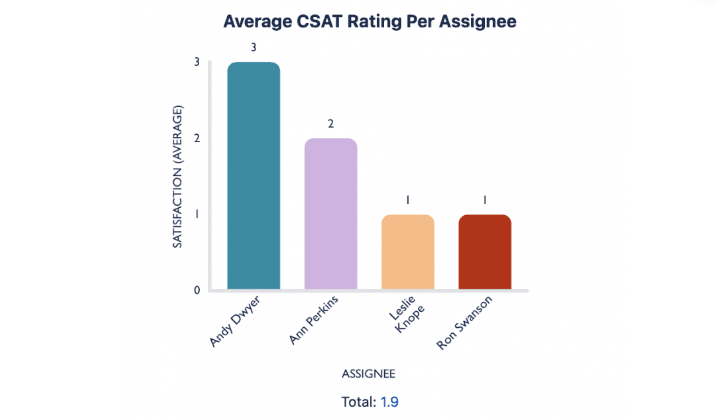
Conclusion
Jira has come a long way from its early focus on software development teams, especially with the introduction of Jira Service Management. IT teams love JSM so much that it was a Gartner Customer Choice this year for ITSM. Atlassian continues to enhance the product with each release and has made it a major focus of their roadmap.
With Custom Charts for Jira, we’re doing the same, adapting alongside them so that users have custom reporting options for all JSM enhancements. The examples above are just a glimpse into how Custom Charts can help ITSM teams be the best they can be.
If you have any ITSM-related requests, or ITSM use cases that our charts aren’t yet covering, feel free to submit a support request. And if you’d like to know more about Custom Charts and how it works, check out our documentation.
Sign up for a demo
Register

